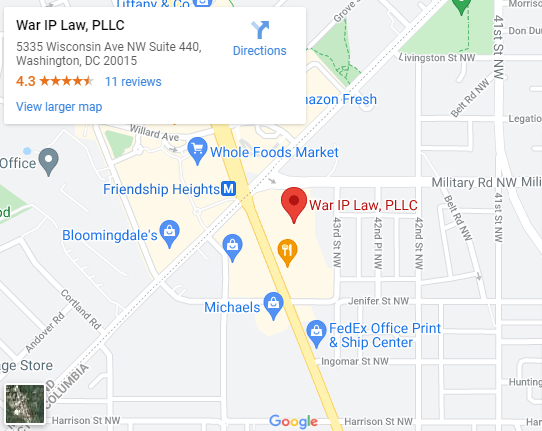It is possible to file an intent-to-use trademark application if you are not yet ready to use your mark in commerce but plan to in the future. When filing this type of trademark application, it is important to list the appropriate applicant — but can an intent-to-use trademark be assigned? To answer this question, it is necessary to understand intent-to-use trademarks and assignments in greater depth. Contact the experienced intellectual property attorneys at War IP Law, PLLC at (202) 800-3754 to learn more about all of your legal options.
Why File an Intent-to-Use Application?
It is important to understand why someone would want an intent-to-use trademark application. This type of application allows a person to file before actually using the trademark in commerce, resulting in an earlier application date — potentially one ahead of a competitor. In the case of a legal conflict, the person who filed first could receive priority for the trademark. Filing an intent-to-use application involves submitting an initial application form and selecting the option “Section 1 (b)” for “Basis for Filing.” It is important to note that there is often a great deal of research that accompanies whether or not a person has the legal right to even file an intent-to-use application, as their mark or intellectual property may already be taken by someone else. Visiting with an experienced IP attorney can help you understand what your legal options are.
The Meaning of “Use in Commerce”
Anyone who files for an intent-to-use trademark must have the intention of using the mark with the applied-for goods and/or services. In terms of goods, future use could be on the products themselves, the packaging, or the point-of-sale displays. For services, the future use could be for the sale, advertising, or services actually rendered in commerce. The owner of the trademark must use the mark in the ordinary course of trade, which means use of the mark cannot be just a token for the purpose of reserving the trademark.
Why Might You Want to Assign an Intent-to-Use Trademark?
It is important to put a trademark in the right name to avoid the United States Patent and Trademark Office (USPTO) declaring it void. An invalid assignment voids the underlying application and registration. The laws of intellectual property can be complex and confusing, and visiting with a seasoned IP attorney can help you learn all of your options.
Can an Intent-to-Use Trademark Application Be Assigned by the Owner?
Trademarks always have an owner as well as an applicant. Through assignment, the owner can transfer the trademark to another person, and this is a relatively common practice. However, assignment is more difficult when the trademark is pending an intent-to-use application. This is because of Section 10(a)(1) of the Lanham Act § 10 (15 U.S.C. § 1060) (often called the anti-assignment or anti-trafficking provision).
The anti-assignment provision means it is not possible to assign an intent-to-use trademark before first filing either an amendment to allege use (AAU) or a statement of use (SOU). An AAU is possible only when the owner has actually used the mark in commerce or in connection with the goods or services named in the application.
An applicant can file a SOU within six months of the USPTO issuing a notice of allowance (NOA) or during any extension period. Either of these involves the applicant submitting an example of how he or she will be using the trademark to sell the products or offer the services listed in the application. The applicant also needs to provide a statement that explains how he or she will be using the specimen in commerce by a particular date. Assigning an intent-to-use application before filing a verified allegation without an AAU or SOU will mean the application or assignment is void.
Exceptions to the Anti-Assignment Provision
There are exceptions to the anti-assignment provision when the intent-to-use trademark is assigned to a successor, either of the entire business or of a portion of the business. The successor must be connected with the trademark. Additionally, the Trademark and Appeal Board (TTAB) of the USPTO and the courts have routinely determined that an exception is inapplicable because it violates the provision in some way.
Furthermore, the transfer to a successor can only be to an ongoing and existing business. This means the applicant must be providing goods or services as specified in the application, although it does not require business for each one of the goods named. The TTAB will determine if the assignee is a successor by considering if:
- A transfer of business and good will of the trademark has occurred
- The management will be continuing
- The assignee is producing similar products or providing similar services to the applicant
- A transfer of assets has taken place
- Documentation supports all of the above
How to Avoid Problems with Your Trademark Application
The above demonstrates that it is important to carefully consider who is named as the applicant for your trademark from the start. An applicant can be a single individual, multiple individuals, or an entity. If an applicant has not yet put a trademark into commerce, naming a single individual would give this person the sole requisite to use the mark, including through an entity the individual organizes at a later date or through a licensee. Alternatively, all the named individuals will have the requisite intention to use the mark. Lastly, if an applicant chooses to name an entity, this entity must already be legally organized and recognized.
Once a person has put a trademark into commerce, they should name the individuals or entity that will be using the mark (using it themselves or through a licensee) as the applicant. The same individuals or entity will also be the owner. However, if a person names individuals as intent-to-use applicants and organize an entity to use the trademark after filing an intent-to-use application, they may only assign an application to the entity who is a successor (meeting the requirements stated above). Additionally, they may make an assignment after they have filed a document with the USPTO stating that the applicant or licensee has used the trademark.
Support with Your Intent-to-Use Trademark
The answer to “Can an intent-to-use trademark application be assigned?” can often seem confusing and challenging to answer. Contact our dedicated legal team at War IP Law, PLLC at (202) 800-3754 for more information and to find out if we can provide you with support for your intent-to-use trademark application.






